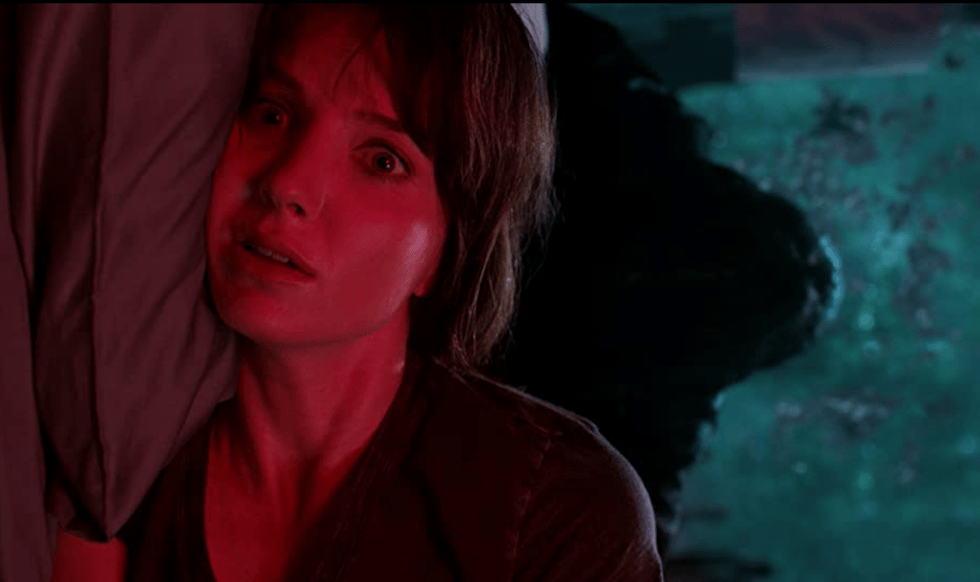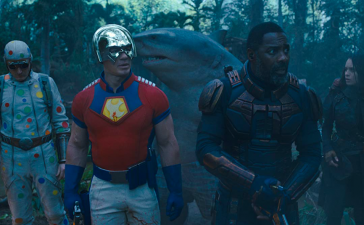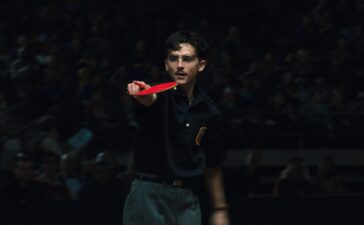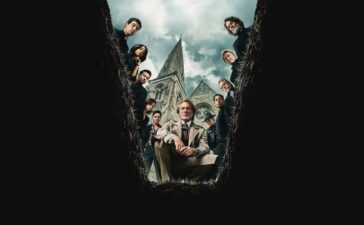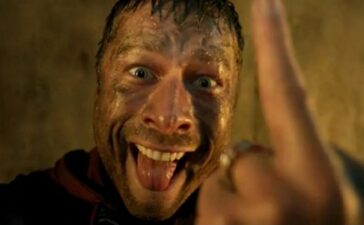The Saw and Aquaman director has returned to his roots with a joyfully grotesque modern gothic terror tale.
Spoilers for Malignant lie ahead.
In his new film, Malignant, Australian director James Wan tells the tale of Madison Lake (Annabelle Wallis), a timid pregnant woman trapped in an abusive relationship whose husband is suddenly, bloodily, and mysteriously murdered. That could be perceived as a stroke of luck, but soon more bodies start piling up, and Madison is having seemingly psychic visions of the murders/ Is she doing it? Is she possessed? Is it something even stranger?
If you guessed three, you’re on the money (and here come the spoilers). The killer is Gabriel, her twin brother that she partially absorbed in the womb, and who now lives inside her, growing a misshapen face out the back of her head when he takes over her body in order to kill the people he sees as threats to their parasitic relationship. It’s a wild idea and a wild movie, building to a gory OTT climax that is one of the best horror set pieces in recent years.
We were lucky enough to horn in on a virtual roundtable with Wan, who was happy to field questions about the latest entry in his horror ledger. Answers have been edited for clarity and length.
How do you see the horror genre in general nowadays?
You know, it’s funny, when I made Saw, even back then there was still a lot of… I wouldn’t say animosity, but there was that tendency to thumb the nose at the horror genre. But I think in the last 10 years it has shifted a lot and horror is very much more well received and accepted by the mainstream now. And you see time and time again that it is the horror genre that saves the industry. Like, whenever the business is down, it’s horror films that come along and pick the industry back up, right? What I like about it is the fact that today’s generation is very accepting of this world and if they love this genre, hopefully they’ll go back and discover all the older ones.
What inspires you when writing a story?
Firstly, what kind of film do I feel like doing next? That’s one part of my process. The other part of my process is if I come across an interesting story, or I come across an interesting idea, or even an interesting character for that matter, I then see if I can build off that. I go, okay, where can I take this idea now? Can this idea be a full-blown story with fleshed-out the characters? And then I take it from there. But ultimately I try to start from a place where I go, am I doing something that’s different? Or at least different for myself as a filmmaker? Am I telling a different kind of story? Because I don’t want to keep repeating myself, but there’s a reason why I didn’t go back and make The Conjuring 3 because I felt like I’ve already made Conjuring one and two and I’ve told the stories I wanted to tell and it was time for me to move on to something different.
But at the same time, I’m so inspired by the movies I grew up with, the filmmakers I grew up with from the ‘80s and ‘90s. I felt that after Aquaman I should go back to a smaller, more intimate horror/thriller, like the kind of movies I started out with: Saw, Death Sentence and Dead Silence, where they were a lot more hard hitting and visceral, with a more gritty style of filmmaking, and I kind of wanted to return to that. So, it was a combination of different aspirations that came together to form Malignant.
What was it like to go back to horror after the big blockbusters Furious 7 and Aquaman?
I tend to do this when I’m making my big budget films: I get really overwhelmed by it. And I tell myself, “Your next movie should be a smaller film.” And then when I’m making my smaller movie, I go, “Oh, I don’t have all the tools I need. The next movie should be a bigger film.” So I ride this wave up and down, fluctuating between what I do. That works very good for me because it keeps things fresh for me. I knew I was going to jump into Aquaman 2, but I didn’t want to make those two films back-to-back. I needed a palate cleanser in between those two films.
And in the last 10 years I’ve become known as the ghost/supernatural jump-scare guy with my Insidious and my Conjuring films and I just didn’t want to repeat myself with that again. That was a big reason why I didn’t want to do Conjuring 3. I wanted to play in the horror genre again, but I just didn’t want to do the same thing.
And so Malignant starts out more like a supernatural story. You’re watching it going ‘Oh, this could be a ghost movie. This could be a demonic possession movie’, but then it shifts into something different, taking that expectation and twisting it.
How did you experiences on those bigger films inform Malignant?
I think Malignant is my 10th movie in my filmmaking career, so that means I have nine movies of experiences behind me by the time I made this one. I take things that I’ve learned from each film and I parlay them into the next film. What I took with me was some of the technical experiences that I had learned from the bigger films. I needed that knowledge to help me bring Gabriel to life. Gabriel is a very technically complex character to bring to life, dabbling in animatronics, puppetry and visual effects and also body performance: a combination of things that we needed to do to bring this villain to, to life. That was part of the fun: it was just challenging to do things I haven’t done before. I haven’t worked with animatronics to this level, or puppetry to this level. And it wasn’t really fun to do so.
Can you give us some insight or walk us through like how you developed the physical look and movement style of Gabriel?
I say that it took a whole filmmaking village to bring Gabriel to life and to shape who he is and what he looks like and how he moves and all that. It really is a combination of just really tell a bunch of really talented people to bring this thing into reality.
Obviously we start off with Annabel Wallace, right? Who has to give us the build-up into this thing popping out the back of her head. And then from there onwards, she gets taken over by Marina [Mazepa] this incredible contortionist/actress/dancer/body movement performer. She’s more than just a contortionist; she took to heart the concept of someone who moves in reverse and backwards. I thought that I was going to shoot with a lot of camera trickery, but I didn’t have to do that. I didn’t have to cheat because Marina was so adept at it. She literally trained how to do all the fights backwards. It was pretty amazing! She’s breaking necks, breaking arms, but in reverse!
And then we would have an animatronic makeup of Gabriel on the back of Marina’s head, so while she’s moving we’re controlling, that to bring Gabriel to life at the same time. It was that challenge at the start of the concept stage that got me excited to want to make this film.


